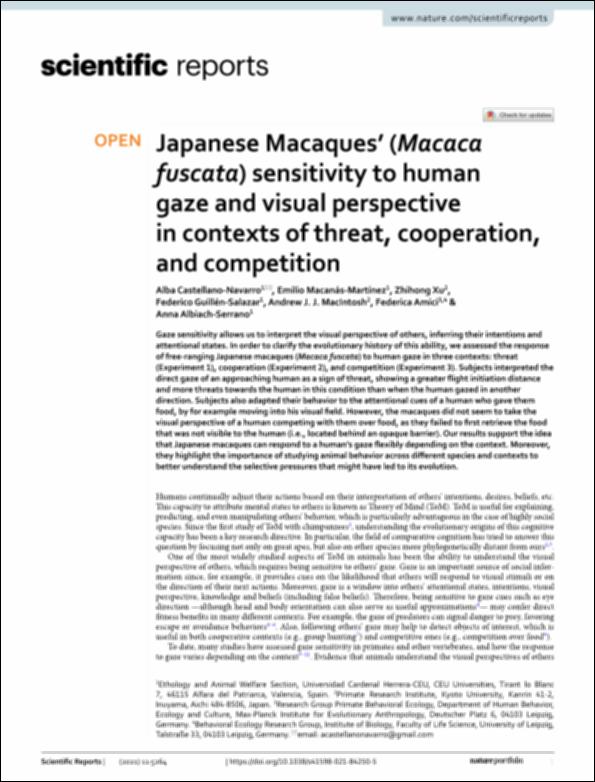Por favor, use este identificador para citar o enlazar este ítem:
http://hdl.handle.net/10637/13692Japanese Macaques' (Macaca fuscata) sensitivity to human gaze and visual perspective in contexts of threat, cooperation, and competition
| Título : | Japanese Macaques' (Macaca fuscata) sensitivity to human gaze and visual perspective in contexts of threat, cooperation, and competition |
| Autor : | Castellano Navarro, Alba Macanás Martínez, Emilio Xu, Zhihong Guillén Salazar, Federico MacIntosh, Andrew J. J. Amici, Federica Albiach Serrano, Anna |
| Materias: | Psicología animal.; Animal psychology.; Macaques - Behavior.; Evolution (Biology); Macacos - Hábitos y conducta.; Primates - Behavior.; Evolución.; Primates - Hábitos y conducta. |
| Editorial : | Nature Research |
| Citación : | Castellano-Navarro, A., Macanás-Martínez, E., Xu, Z., Guillén-Salazar, F., MacIntosh, A., Amici, F. & Albiach-Serrano, A. (2021). Japanese Macaques' (Macaca fuscata) sensitivity to human gaze and visual perspective in contexts of threat, cooperation, and competition. Scientific Reports, vol. 11, i. 1 (04 mar.), art. 5264. DOI: https://doi.org/10.1038/s41598-021-84250-5 |
| Resumen : | Gaze sensitivity allows us to interpret the visual perspective of others, inferring their intentions and attentional states. In order to clarify the evolutionary history of this ability, we assessed the response of free-ranging Japanese macaques (Macaca fuscata) to human gaze in three contexts: threat (Experiment 1), cooperation (Experiment 2), and competition (Experiment 3). Subjects interpreted the direct gaze of an approaching human as a sign of threat, showing a greater flight initiation distance and more threats towards the human in this condition than when the human gazed in another direction. Subjects also adapted their behavior to the attentional cues of a human who gave them food, by for example moving into his visual field. However, the macaques did not seem to take the visual perspective of a human competing with them over food, as they failed to first retrieve the food that was not visible to the human (i.e., located behind an opaque barrier). Our results support the idea that Japanese macaques can respond to a human’s gaze flexibly depending on the context. Moreover, they highlight the importance of studying animal behavior across different species and contexts to better understand the selective pressures that might have led to its evolution. |
| Descripción : | Este artículo se encuentra disponible en la siguiente URL: https://www.nature.com/articles/s41598-021-84250-5.pdf |
| URI : | http://hdl.handle.net/10637/13692 |
| Derechos: | http://creativecommons.org/licenses/by/4.0/deed.es |
| ISSN : | 2045-2322 (Electrónico) |
| Fecha de publicación : | 4-mar-2021 |
| Centro : | Universidad Cardenal Herrera-CEU |
| Aparece en las colecciones: | Dpto. Producción y Sanidad Animal, Salud Pública Veterinaria y Ciencia y Tecnología de los Alimentos |
Los ítems de DSpace están protegidos por copyright, con todos los derechos reservados, a menos que se indique lo contrario.


